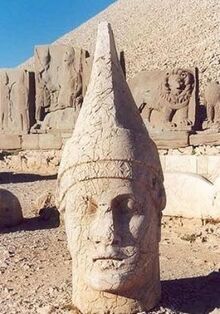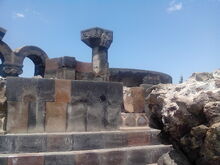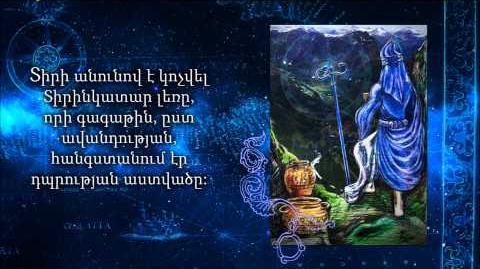
Statue of Tir on Mt. Nemrut, present day Turkey
Tir is the god of literature, science, and art, and an interpreter of dreams, in Armenian paganism. Tir was a messenger of Aramazd. He was a fortune-teller and a guide of the dead person's soul. Another name for Tir was Grogh (meaning writer or scribe), though this might be a fusion of two originally distinct deities.
His biggest temple, known as the Erazamuyn (translated from Armenian "place where dreams are explained"), stood at what is today the ruined Zvartnots cathedral; the original design of the temple is still very evident in its construction as it is very different from the typical Armenian church, being circular, elevated by large steps and lined with columns. At Tir's temple, priests would interpret peoples dreams and tell their fortunes, and the temple also served as a library and academy. Ruins of another temple to him was found near the ancient city of Artashat in Ararat valley. He is among the pantheon of gods represented on Mt. Nemrut, an ancient site now located in Turkey.
Role in Armenian mythology[]

The ruins of Zvartnots, a cathedral built over Tir's temple Erazamuyn.
Tir acted as a scribe to the gods, and when someone was born he would write their name into the Book of Life; and on the forehead he imprinted the newborn’s fate, predetermining the given lifespan. He keenly observed everyone and entered all the sins and good deeds into his special folio, to read them during the final judgment.
If the agony of dying lasted a long time and the soul could not part with the body easily, it was common to take the pillow from beneath the head of the dying person and open wide all the windows and doors, so Tir could enter freely into the home and take the soul into his bosom and leave.
Just as the Russians curse ‘k chorty’ meaning ‘to the devil’ and English ‘to hell with you’, up until modern times Armenians curse by sending to someone to Tir: “Grogh kez tani!” (in Armenian: "Գրող քեզ տանի:", meaning “scribe take you!”) or “Groghu tsots” (“in embrace of the scribe”). Many centuries passed and the word “Grogh” came to simply mean ‘writer’.
As a god of writing, his existence might well be taken as evidence that an Armenian alphabet existed in pagan times, contradicting traditional Christian Armenian history which puts the invention of the alphabet in the 400s CE by St. Mesrob Mashtots.
He is identified with the Greek god Apollo and the Zoroastrian god Tishtrya.
Holidays[]

A video on Tir (in Armenian)
The 21st of September was celebrated a Holiday in honor of Tir. This day was dedicated in memory of ancestors, and is still celebrated today by Christians who visit the graves of loved ones, though one week earlier as the 21st is now Armenia's independence day. Traditionally on this day people were shown theatre, and told about their voyages over the world. Tir’s holiday was celebrated at the beginning of the Armenian month of Hori (Sept. 10-Oct. 9) as a day of knowledge. He even had a month, Tre (Nov. 8 to Dec. 7), dedicated to him in the old Armenian pagan calendar.